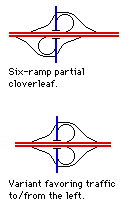Six-ramp partial cloverleaf interchanges

The six-ramp partial cloverleaf allows traffic on the side street to flow more smoothly than a plain diamond, since the only crossing traffic comes off the two exit ramps. Each side of the street has an easy right turn to either direction on the freeway. California engineers often call them "three-quarters" interchanges, since six of eight possible ramps are included.
Since no left-turn lanes are required on the surface street, all its lanes can be used for through traffic; this is especially beneficial if the street passes over the freeway.
In California, intersections that once had cloverleafs are being redesigned and rebuilt for six-ramps. The addition of yet another traffic light where there was none before is disappointing (and generates a fair amount of criticism from laypersons), but the six-ramp does not suffer from the weaving motions caused by a full cloverleaf.
There are infrequent instances of the modified six-ramp (bottom), where both loops are on one side of a road. This is usually done if freeway traffic is lopsidedly heavy to and from one direction. This does reintroduce weaving motions, but traffic on the side street is often slower and conditioned to stop-and-go situations.
Links
- Interchanges
- Glossary
- Culture: interchanges in movies, computer games, etc.
- Diamond and other 4-ramp designs
- Six-ramp partial cloverleaf
- Cloverleaf
- Trumpet and other 3-way interchanges
- Stack and other heavy-duty 4-way interchanges
- Volleyball: an odd 3-level 4-way treatment
- SPUI: Single-Point Urban Interchange
- Oddities: Some strange or fictional interchanges